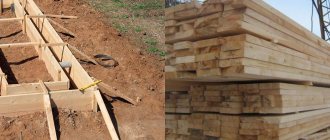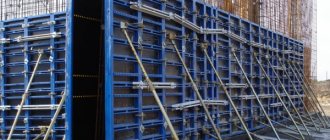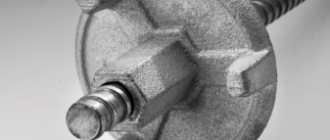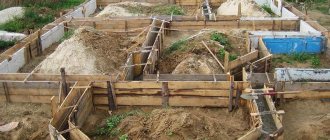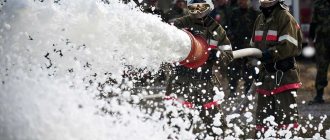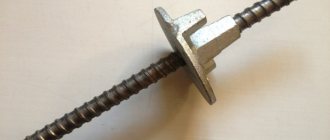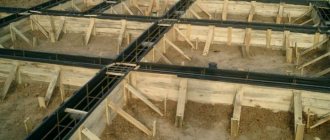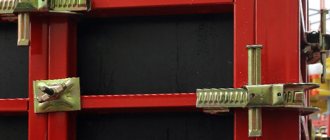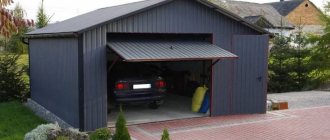Concrete work, with rare exceptions, is a component of the cycle of construction activities for the construction of structures - from a small outbuilding to a monolithic multi-storey building. Concreting makes it possible to quickly, without significant expense, obtain durable structures for foundations, floors, walls, and partitions. The use of multi-turn formwork panels, their quick installation, and easy disassembly significantly reduces the delivery time of the finished object and reduces costs. Lubrication is intended to make working with formwork easier and extend its life.
Without lubricant, this small-panel formwork will be difficult to disassemble
Need for lubrication
The concreting technology provides for compaction of the poured mortar in order to eliminate shells and cavities inside the future monolith. The task is performed with a deep vibrator or by tapping the surface from the outside in places of contact with concrete. These methods help remove air bubbles from the solution mass. The entire volume inside the formwork, up to a small unevenness or crack, is filled only with concrete.
Compacting the solution with a deep vibrator
The disadvantage of compacting the pouring is the difficulty of disassembling the formwork, its possible damage, complete unsuitability for reuse, the likelihood of mechanical damage to the fresh pouring (when the panels are separated from the concrete plane). Lubrication helps to simplify and speed up the laying of the monolith. The inner surface of the installed panels is coated with the composition before filling with the working solution.
The wetting ability of materials varies. Therefore, the frequency of processing panels differs. For example, wooden and plywood ones are lubricated before each use, plastic ones - every fifth time.
A thin separating layer is created between the concrete and the formwork elements. This film minimizes adhesion of treated panels. Their dismantling after the concrete has set is simplified, and their service life is increased by up to three times. The use of the products affects the quality of the concrete surface - it has almost no chips or cracks.
Types of lubricant mixtures
The classification of anti-adhesive solutions is based on their chemical composition and technical characteristics.
Aqueous suspension
A simple, economical option. You can make it yourself from available materials. According to the recipes of experienced craftsmen, suspensions from alabaster, building gypsum, lye, clay, and lime are easily prepared. There are also plenty of other folk recipes.
After thorough mixing, all compositions of the group are applied to the formwork elements and the treated surfaces are allowed to dry. Forms for pouring concrete from such panels cannot be tapped; concrete compaction is carried out without a vibrator. The reason is the lack of elasticity of the layer of dried lubricant, which easily peels off under shock and mechanical influences and mixes with the contacting solution. The contaminated surface layer of a monolithic structure has reduced strength. Therefore, the use of aqueous suspensions is suitable for small structures using bayonet to compact the poured mortar.
Water repellents
They have a high saponification coefficient, which characterizes the effectiveness of protecting equipment from wetting upon contact with the solution. Components of the compositions: mineral oils, surfactants. Water repellents create a reliable layer on the inside of the panels. Disadvantages - the cost of lubricants, their fire hazard, the existing risk of oil stains on the surface of concrete.
Water repellents for any surface work according to the same principle:
Based on organic hydrocarbons – retarding
Organic carbohydrates are the basis of the products. The applied layer slows down the setting speed of the mortar. Therefore, the solution in contact with the formwork still has plasticity and pliability, the rest of its volume has already set to its entire thickness and has become quite strong. Dismantling the panels and cleaning them from adhering concrete particles is easy. The disadvantage of retarding solutions is the inability to control the hardening process of the surface layer of concrete. Cracks may appear at the junction of hardened concrete and a thin plastic layer due to internal stresses.
Combined
Reverse emulsions (another name for combined mixtures) include water-repellent components, concrete mix retarders, and plasticizers. They are easily held on a smooth, vertical surface; the emulsion does not delaminate for several days. The combined lubricant makes the pores of the concrete surface small, which improves the density, strength, and moisture resistance of the resulting monolith. Experts consider the use of reverse emulsions optimal for processing formwork panels.
With lubricant, the shields are intact, the concrete is without damage
Differences in lubricant composition
There are several types of lubricants based on their composition:
- Water based;
- With a combined base;
- With a substance that slows down the hardening of concrete.
- With a substance that repels water.
The first type is made from chemicals that are inert to concrete. They are relatively low in cost, so they cannot always effectively cope with the problem.
The second type is the most persistent. It does not delaminate within a week. Excellent adhesion to the surface. They are often reverse-purpose emulsions.
The third type introduces chemicals such as molasses or tannin. At the same time, complex regulation of the foundation setting process is noted.
The fourth type is made from a variety of oils, such as minsoal or salts of fatty acids, as well as the presence of the form lubricant EKS emulsol. They create a thin layer that repels water. At the same time, they may have disadvantages, such as overpriced.
Commonly used lubricants
It will be easier for a developer without specialized education to choose the right composition from the assortment offered by construction markets if he knows the characteristics of popular products.
- Agate. A universal water-free oil composition for coating formwork panels made of any material. A special feature is the absence of surface traces of material on dried concrete.
- Tiralux. Expensive German composition based on mineral oils and anti-frost additives. It has protective properties - concrete does not stick even to board panels.
- Angrol. Fireproof emulsion with a long shelf life without loss of declared characteristics. Protects metal surfaces of equipment from corrosion.
- Emulsol. Lubricant with mineral oils, easy to apply and low consumption. The Emulsol-ExIM brand composition can be used to coat structural panels at significant temperature drops - down to -35°C.
TiraLux - expensive but popular composition for application to formwork
Consumption per 1 m2
The consumption of formwork lubricant depends on a number of factors:
- Mass density. The denser the composition (thicker), the more it is consumed. For example, Emulsol lubricant, being the densest of all, is consumed in fairly large quantities.
- Operating temperature. In the cold, the mass thickens and more is needed. But due to the reduction in fluidity, this can be a plus when working in winter.
- Method of application. It is more economical to use a gun; consumption will increase when using a brush. The maximum amount of lubricant is consumed when using a roller.
- The time between assembling the formwork and pouring the concrete solution. If concrete is poured immediately, the consumption will be less.
- Tilt of the lubricated plane. Lubricating horizontal surfaces requires less lubricant than vertical ones.
- Material of formwork panels. On horizontal surfaces, consumption is lower if the formwork has low adhesion. On vertical planes, on the contrary, the higher the adhesive ability, the lower the consumption.
Table: consumption of various types of lubricants
| Lubricant type | Consumption (in grams per 1 square meter) |
| Angrol | 50–70 |
| Emulsol | 50–100 |
| Tiralux | 15–30 |
| Agate | 50–100 |
Table: lubricant consumption taking into account the method of application, time of year, type and slope of the surface (in ml)
| Material of formwork panels | Horizontal plane | Vertical plane | ||
| Gun | Brush | Gun | Brush | |
| Summer time | ||||
| Metal, plastic | 300 | 350 | 400 | 430 |
| Tree | 320 | 350 | 450 | 420 |
| Winter time | ||||
| Metal, plastic | 300 | 400 | 350 | 400 |
| Tree | 300 | 400 | 300 | 350 |
Requirements for lubricant mixtures
It is not necessary to treat the equipment with waste machine oil or fuel oil in the old fashioned way. These materials are hazardous to the environment, fire hazards, and not always effective. When producing ready-made products, construction requirements and standards are taken into account. Here are the main ones:
- Bringing the chemical composition closer to a neutral state should protect the respiratory tract and exposed skin areas of construction workers. At the same time, the operational characteristics of the structure at the points of contact of the lubricating film with concrete should not be reduced.
- The product, while reducing the adhesion of concrete to the formwork material, should not have penetrating properties. After contact there should be no oily or greasy stains left. If they are not removed, finishing materials (adhesive mortars, plaster, coating insulation) may not adhere to the concrete surface. And stain removal is associated with mechanical damage to the surface of the monolith.
- To resist the alkaline environment of concrete pouring and obtain a high-quality soap film on the surface of the formwork elements, the saponification coefficient cannot be reduced below 7 units. Compliance with this requirement will prevent particles of the solution from sticking to the inner surface of the form-building panels.
- The composition of the product must provide the substance with sufficient viscosity and resistance to liquefaction from hot air. The high-quality material stays on the smooth vertical plane of the shield for 24 hours without draining or evaporating.
- The lubricant must be safe for humans.
- The coating used must serve to protect the formwork material: from corrosion - for metal, from rotting, damage by microorganisms - for wood.
- Application of the coating should be easy, with economical consumption of the working substance.
Treatment
Processing of the structure occurs after its assembly is completed. This will reduce lubricant consumption. Previously poured, hardened concrete is protected with film or tarpaulin. The surface to be treated is first cleaned of solution residues, dirt, and dried well. The coating of the product used should be uniform and thin.
When applying lubricant, it must not come into contact with embedded products or the prepared reinforcement frame; the elements must maintain high adhesion to the concrete mortar.
An economical option is spraying with a paint gun. You can work with a roller or brush. The use of an ordinary paint brush is especially justified when processing the surface of joints, in the corners of formwork, and plank panel structures.
The spray gun provides uniform, economical spraying
Features of preparation and application
Lubricants are available for sale that are ready for use, and concentrates that require preliminary preparation. The solution must be prepared strictly according to the manufacturer’s instructions - each type of concentrate requires its own components and proportions. For example, to prepare lubricant from Emulsol concentrate, you will need the concentrate itself and water, taken in a ratio of 1 to 2, respectively.
How to work with lubricant correctly:
- Mechanically clean the panels from any remaining concrete mixture from previous use.
- Assemble the formwork.
- Immediately after assembly, lubricate it with the prepared or prepared composition. This can be done with a roller, brush or spray. The last method is the most economical. The optimal distance from the sprayer to the lubricated plane is 1 meter.
Attention! To maintain the strength of the concrete structure, it is necessary to cover the already poured concrete with a film before lubrication. Otherwise, the new mass will not be able to adhere to it.
Concrete can be poured after the greased surfaces have dried. You can check the readiness of the formwork for work by moving the formwork. If the lubricant does not flow down when moving, you can start pouring the concrete solution.
Manufacturers
For formwork processing, products from reputable manufacturers are often chosen. Among foreign brands, the leader is the German Tiralux 1721, a mixture of the Greek concern Isomat. Russian universal lubricants Emulsol EKS-A, Angrol-Monolit, Divikon have positive recommendations. When choosing a manufacturer, it is better to choose a company operating in a narrow segment of product manufacturing (for example, Nizhny Novgorod “N Petros”). Then you can rest assured of the high, constant quality of the composition.
The use of lubricants for processing formwork structures cannot be considered additional costs. These investments will be returned many times over by speeding up construction work, increasing the service life, turnover of removable formwork, and improving the quality of erected concrete structures.
An example of applying a release agent to molds for the production of concrete slabs, the result:
Average score of ratings is more than 0
Share link
Comments There are no comments yet, but you could be the first...
